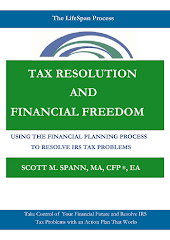With the potential for significant tax law changes looming on the horizon strategic planning becomes necessary now more than ever to help preserve and build wealth. From a historical perspective, Americans are currently enjoying favorably low income tax rates. Unfortunately for affluent individuals and families this is soon likely to change. With massive government spending and growing federal deficits it is becoming apparent that changes to the tax code are inevitable and significant tax hikes will likely occur in the not too distant future. So, beyond participating in tax deferred retirement accounts (401k, 403b, IRA, Roth IRA, etc.) what can investors do to protect their current and future assets from these expected tax rate increases?
There are a number of different tax strategies available to consider in advance of these expected tax increases. However, one thing to keep in mind is that tax considerations should never be the sole basis for a planning strategy. Income tax planning is just one part of a comprehensive financial plan. Consider the following strategies as you adapt your financial life plan to the possibility of higher taxes.
Establish a comprehensive plan
The best starting point in preparation of future tax increases is to have a plan in place prior to tax law changes. One of the biggest mistakes that many investors are making today is taking a "wait and see" approach and not being proactive. Comprehensive planning strategies help prepare for life's uncertainties and add meaning and purpose to important decisions related to taxes and other money matters. If you are investing for future life goals and objectives, be sure that you have a written set of guidelines to help you track investment decisions. An investment policy statement should be used to help monitor investments and take into account all potential tax implications.
Shifting income
While there is no guarantee that we will see an increase in tax rates during 2010, it does not hurt to be prepared. In some cases it may make good sense to receive ordinary income in 2009 rather than in 2010 when tax rates may be higher. The highest marginal income tax rate is currently 35%. If you have non-qualified stock options you should consider exercising the options in 2009 if you anticipate moving into a higher tax bracket the following year. Small business owners and investors who have control over when income is received should also consider receiving ordinary income in 2009 rather than in a later year when rates may increase.
Capital gains
If the tax cuts that were initiated during the Bush Administration are allowed to expire, the highest capital gains rate will move from 15% to 20%. If you have investments that have increased in value over the past few years you could consider taking capital gains in 2009 while rates are at their lowest levels. Of course this should only be done if it makes sense from a strategic asset allocation perspective and you were planning on selling within the next 3-5 years anyway.
Tax efficient mutual funds and ETFs
Some mutual funds do a better job than others with tax efficiency. As income tax rates rise, the importance of monitoring the tax efficiency of investments held in taxable accounts becomes essential. As an investor, it is necessary to find money managers who are capable of balancing investment returns with tax considerations. Keep in mind that after-tax investment returns should be taken into account. Do not simply focus on pre-tax investment returns.
Index mutual funds and exchange traded funds (ETFs) are excellent investment vehicles from a tax efficiency standpoint. Traditional index funds and ETFs are, by nature, tax efficient — and cheap. The mutual fund industry also has a wide selection of tax-managed offerings that focus on minimizing taxation. The bottom line is as tax rates go up, the need to focus on tax efficient returns increases for investments held outside tax advantaged accounts such as IRAs or 401ks.
Variable Annuities
Although variable annuities are not my favorite investment vehicles due to cost and other factors, they do have a place in some financial planning situations. Annuities allow investors the opportunity for tax deferred growth and investment gains are not taxed until they are withdrawn. Upon withdrawal variable annuity income is taxed at ordinary rates (penalties may apply to withdrawals prior to age 59 1/2). The tax deferral of annuities becomes more appealing in a rising interest rate environment. If you are considering variable annuities, focus your search on low cost options available through a Fee Only financial planner.
Municipal Bonds
Municipal bonds are another investment vehicle that becomes increasingly appealing for taxable brokerage accounts as tax rates increase. This is due to the increase in the taxable equivalent yield of municipal bonds. Municipal bonds and municipal bond funds provide federally tax-exempt interest. In some cases state and local taxes may also be tax-exempt. If you are reviewing alternatives for the fixed income portion of an asset allocation plan, be sure to consider municipal bonds for your brokerage account.
The taxable equivalent yield calculation is as follows:
Tax-Equivalent Yield = Tax-Free Interest Rate ÷ (1 – tax rate)
So, if the municipal bonds interest rate is 3% and the highest tax rate increases to 40% the tax equivalent yield is 5% (3 divided by .60 equals 5%).
Buy and hold, but do not forget
I have never been a strong advocate of active trading. Active trading adds additional costs and historically underperforms passive investment approaches. The most important determinant of investment performance over time is asset allocation. While investors cannot control the movements of securities markets, they can control costs. As capital gains rates increase, the tax deferral strategies when using a buy and hold approach provide a valuable element of defense. If you have a long-term time horizon for investments, you will likely see a variety of tax law changes during the lifetime of your investment holdings. Buy and hold strategies help defer capital gains taxes until the actual sale.
In summary, aside from Roth IRA's, 401k's, and other tax deferred retirement accounts there are other options investors must be aware of to protect themselves from an increase in tax rates. As the old saying goes, the only constant in life is change. Tax laws in America are about to do just that- change. We don't know exactly when or how much, but tax rate changes are coming. The biggest line of defense is to be proactive and establish a comprehensive financial plan that focuses on investments, taxes, and other aspects of your financial life.
Subscribe to:
Post Comments (Atom)





No comments:
Post a Comment